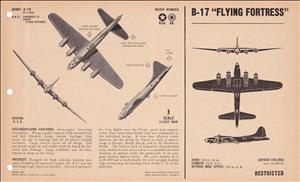On July 28, 1935, the Model 299 prototype for the Boeing B-17 Flying Fortress takes off from Boeing Field on her maiden flight. The four-engine behemoth roars down the runway and, as it climbs into the air, is greeted by the rising sun over the Cascade Mountains, which glints off its polished wings. One reporter dubs it a "veritable flying fortress." The 299 will go on to set a new speed record on August 20 by flying 2,100 miles nonstop from Seattle to Wright Field in Dayton, Ohio, at an average speed of 232 miles per hour. However, the airplane crashes during later tests.
Boeing Gambles the Company
Less than a year earlier, on August 8, 1934, a circular addressed to Boeing had arrived in the mail from Wright-Patterson Air Force Base in Dayton. The circular contained specifications for a multi-engine bomber that could carry 2,000 pounds of bombs over 2,000 miles. The document asserted that any company that could produce such a plane would receive a production order for at least 20 aircraft. Good news for Boeing and the depression-era workforce, if it could actually be built.
Boeing was in a slump. In early 1934 total employment was 1,700, but by August it was down to 600. The 247 commercial transport was not selling well: Profits were down. By the end of the year the company was $266,000 in the red. Nevertheless, the board of directors voted $275,000 for the design and construction of the bomber, effectively betting the entire company on one project.
A Veritable Flying Fortress
Because a super-airplane of this type had never been designed before, old engineering methods were set aside. In their place, new ideas in aircraft design were implemented - a wing so large that a crawlspace was built in it to allow the engines to be accessible during flight; a flight deck instead of a cockpit, with enough space for a flight engineer, navigator, radio operator, and two pilots; two tons of landing gear; a kitchenette with a hot plate.
"Multi-engine" was a phrase usually used by the Air Corps to describe twin-engine planes, since tri-motors were occasionally submitted. Chief engineer Claire Egtvedt used this phrase to Boeing's advantage and opted for four engines, another innovation. Costs escalated. The board kept the faith and voted in another $150,000 needed to complete the project.
Until maiden flight, the plane was covered in canvas for military security reasons. Newspaper reporters at Boeing Field stood by in awe and amazement as it was unveiled and put through taxi trials. The size and sturdiness of such an airplane had never-before been seen. As the mammoth took to the air, one reporter described the plane as a "veritable flying fortress," and the name stuck.
Tragedy in Ohio
The Model 299 flew from Seattle to Wright Field, in Dayton, Ohio, on August 20 with Boeing test pilot Les "Cowboy" Tower at the controls. It covered 2,100 miles in nine hours, maintaining an unprecedented average speed of 232 miles per hour.
Flight tests continued under the watchful eye of the Air Corps, with great success. Twin-engines planes from Martin and Douglas were in the competition, but it was obvious to all that the Flying Fortress would be the ultimate winner. Then, tragedy struck.
On the morning of October 30, 1935, the plane took off at Wright Field for further testing. As it cleared the ground, it started climbing too steeply. It headed almost straight up, then fell off on one wing. It sliced through the sky, crashed into the ground, and exploded, killing Les Tower and Major Pete Hill.
The crash was attributed to a gust lock that was still engaged. Although the Air Corps declared that the accident was not due to any structural or design flaws, Douglas ended up winning the contract for 133 B-18 bombers. Fortunately for Boeing, all was not lost. The Air Corps, impressed with the B-17, awarded a second contract for 13 B-17s.
Going to War
Boeing's future depended almost entirely on this contract. Time, being the best test of an aircraft's worthiness, eventually saved the company. By World War II, the Douglas B-18s were relegated to training flights, owing to their slowness and lack of defensive armaments. Meanwhile, the Flying Fortress, through ruggedness and speed, quickly became one of the many "heroes" of the war.
The plane was a hero at home, too. During peak production, more than 200 Fortresses were turned out every month. Overall, Boeing turned out 6,981 aircraft and Vega and Douglas produced another 5,745 B-17s under license, for a total of 12,726 airplanes (Redding and Yenne, 74).
The success of the B-17 led to the creation of the B-29 Superfortress, and Boeing began conceptual work on its B-47 and B-52 jet bombers before the war's conclusion. The B-17 also provided the foundation for Boeing's Model 307 Stratoliner, which in 1939 became the world's first pressurized, high-altitude airliner.

